The Horse's Digestive System
By Amelie Kokorsky
The Path of Food Through the Horse
No horse can survive for any length of time without eating. Every horse owner will probably know that. But what actually happens to the apple we have given our horse after it has put it in its mouth? And how does the horse actually obtain energy from grass? We will take a closer look at these questions today.
Mouth Area
The journey of any food begins in the horse's mouth. The animals stand on the pasture or in the box and eat pasture grass or hay. The grass contains many nutrients that the horse cannot easily access. In order to be able to use the nutrients in the body, many metabolic processes have to be set in motion. The very first step is the intake of the feed via the lips and front incisors into the horse's mouth. Horses are able to "pre-sort" the food with their lips and they only eat what they like. This phenomenon is certainly familiar to many horse owners who have tried to sneak a tablet under the feed of their four-legged friends. The horses actually manage to eat almost all of the feed and only leave the small tablets in the trough. Sometimes annoying for the owners, but very important for the horses. In nature, the animals can sort out exactly what is good for them and what they should rather not eat. Wild horses are also able to find small tufts of grass between barren, stony rocks and sort them out from the stones. An ingenious invention of nature.
Tip: Observe how elephants handle their trunks in the zoo. These giants are also extremely sensitive and can also sort their food without any problems.
With their incisors, the horses can also "nibble off" short grass very well. The tongue slowly pushes the ingested food back and forth in the mouth area towards the cheek teeth. The cheek teeth have a much larger and flatter surface than the incisors and can grind even harder straws. Should the horse accidentally ingest a food component that is not on its menu or could harm the animal, such as a poisonous plant, this part of the food can be transported out of the mouth via the side. The food is also properly salivated in the mouth area. The saliva and its quantity is very individual from horse to horse, but it has several essential functions for the animal. On the one hand, saliva contains important enzymes, which are later important for digesting proteins. On the other hand, the saliva on the feed serves as a buffer function in the stomach. The pH value in the stomach is better regulated by the salivated food mush. Without saliva, the stomach would quickly become too acidic - this can promote diseases of the gastric tract. If the horse does not chew sufficiently, the food is not salivated enough and thus remains drier and harder - no mucilaginous food pulp is produced. The dry food passes much more awkwardly through the horse's long oesophagus and can even get stuck there. A pharyngeal blockage can develop.
Tip: Be patient when feeding your horse. Some horses seem to be real gourmets when it comes to eating, and that is a good thing! Especially with concentrated feed rations, the horse makes much less chewing movements than when eating hay. Therefore, you should by no means encourage the animals to eat faster. On the contrary: It is even optimal (for hasty eaters) to mix a little hay with the concentrate so that the horses also have to chew more when eating concentrate.
Once a healthy horse has chewed its feed thoroughly and salivated it, the food pulp is swallowed and enters the pharynx.
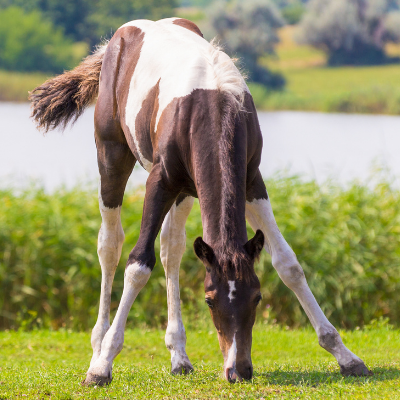
Gullet
The gullet is the transition from the mouth to the stomach. Depending on the size of the horse, the gullet is about 120-150 centimetres long. The diameter is relatively small, about 1.5 centimetres, and is the reason why horses tend to get constipated quickly. It has long been no secret that horses, unlike us humans, cannot throw up when they feel sick. This may not sound bad at first. But conversely, it also means that anything that has once landed in the stomach can only be excreted via the further digestive tract. A possible toxin therefore remains in the horse's body for a long time and has to pass through its digestive tract completely. However, nature did not "invent" this process without reason. If you see a herd of horses in a meadow, you will notice that most of the animals can eat continuously without having to lift their heads to swallow. This is again a great advantage for the horse as a "continuous eater". So once the horse swallows properly, the food mush is transported through the gullet and ends up in the stomach at the end of this tube.
Stomach
If you look at your horse, you quickly get the idea that the stomach must be quite large given the size of the animal. But the horse's anatomy shows something quite different. The horse's stomach is relatively small in relation to the horse and can only take in small amounts of food mush at a time.
Tip: Feed many small portions throughout the day and avoid long feeding breaks. Few large portions with long feeding pauses should be avoided.
Because of the small size of the stomach, the food mush only stays in the stomach for about 2-6 hours and then continues its journey to the small intestine. Long feeding breaks should be avoided because the horse's stomach is actually never completely empty under good feeding conditions. The horse is a "continuous eater" from birth. Its entire digestive tract is designed to constantly digest food. If the horse is deprived of food for a longer period of time, the food mush automatically lingers longer in the stomach and faulty fermentation can occur. This mal-fermentation can harm the animal and lead to diseases of the gastric tract. So cutting off the feed of a horse that is too fat is definitely the wrong way to go. The horse will most likely lose weight, but the risk of getting sick can greatly increase. The horse's stomach can produce up to 30 litres of stomach acid a day. The production will not stop even if the stomach is empty because of wrong feeding! A thick mucous membrane in the stomach protects against the naturally produced stomach acid, so that the stomach cannot digest itself, so to speak. Ideally, the acid in the stomach does not float as a single acid in the stomach either, but mixes with the constantly supplied food pulp. However, if the horse cannot eat any more food, the stomach is slowly emptied and the stomach acid remains without a binding agent. If this happens too often, even the thick stomach lining can be attacked by the acid - the stomach overacidifies and diseases can develop.
Tip: To ensure optimal digestion of concentrated feed, roughage should be fed 30 minutes BEFORE giving concentrated feed. Proteins from the concentrated feed can then be utilised much better.
The intake of sufficient water is also part of the daily food intake. However, the absorbed water only remains in the stomach for a very short time and is more or less immediately passed on into the small intestine.
Small intestine
The structure of the small intestine is divided into three sections, each of which has different tasks in digestion. We will go into these in more detail later. The small intestine of horses can be 20-30 metres long and the volume can be up to 60 litres. Both figures sound very high at first, but in relation to the body weight of a horse, the small intestine is relatively small. The passage of the mash through the small intestine is also surprisingly fast. On average, the mash only stays in the small intestine for about 45 minutes. If you consider the length of the organ again, you realise how quickly the food mush moves through the small intestine. The issue of the constant availability of food also plays an important role here, because only if the horse constantly eats food does the food mush move through the small intestine in a time of about 45 minutes. If the pauses between meals are too long, the food slips through the small intestine too quickly. Normally, the food mush should move about 30 cm per minute towards the large intestine. However, this speed also depends on the size of the food particles in the small intestine. The smaller the food particles are, the slower they move forward in the small intestine. Larger food components, on the other hand, move much faster through the intestinal tract. Concentrated feed, such as oats, is almost devoured by many horses and only chewed up a little, so that the food components only remain in the small intestine for a short time.
Tip: The horse should also chew the concentrated feed properly. You can put large stones in the manger so that the horse can only eat small portions and needs longer to eat the amount of concentrate. Adding hay also helps to increase chewing. I like to feed my horse some sunflower seeds to help him chew a little more and not devour his oats.
The timing of the concentrates should also be right. It is best to feed the horse its concentrate after giving it roughage. Especially after longer breaks in feeding, the order is even more important, because otherwise the concentrated feed is excreted almost undigested and the important nutrients cannot be absorbed by the digestive tract. The concentrated feed thus loses part of its function and task.
Tip: Observe the order! First roughage, then concentrate!
Since concentrated feed passes through the small intestine faster than roughage despite all efforts, it makes sense to feed several small portions throughout the day instead of one large portion.
Before we move on to the individual sections of the intestine, let's take a look at an exciting invention of nature: Surface area enlargement. The small intestine has a very large surface area that is responsible for filtering nutrients out of the food mush. A large surface area is therefore very important for the absorption of nutrients from the food eaten. You can think of the small intestine as a tube with an incredible number of folds and curves. In these folds there are many small villi on the inside of the small intestine wall, which increase the surface area of the small intestine many times over. The structure of the inside of a small intestine wall is somewhat similar to the appearance of a massage ball/ hedgehog ball with many small villi on the surface. The principle of surface enlargement with the many folds can still be seen in some radiators in the house today. These heaters also often have undulations or invaginations on the surface to increase the warming surface. The fine structure of the small intestine explains the effective work of the organ.
Duodenum
The intestine would theoretically have a big problem with the food mush that enters the small intestine directly from the stomach, because this mush is much too acidic in pH. The digestive enzymes in the small intestine would die off in such an acidic environment. The duodenum is the first section of the small intestine. It therefore borders directly on the stomach outlet and receives the food pulp from there. The entrances of the pancreas are also located at this point. The pancreas is enormously important for the entire small intestine because it secretes secretions that neutralise the food pulp and thus increase the pH value. When the pH is significantly high, the digestive enzymes can do their work and begin the digestive processes. The mucous membrane in the duodenum also produces mucus, which combines with the food pulp and neutralises it even more on its way through the entire small intestine. Absorbed sugars and amino acids are split right at the beginning of the small intestine, in the section of the duodenum. Cleavage is important because the large sugar molecules cannot be absorbed by the intestinal mucosa. So in order for sugar to make the journey through the organism, it must first be broken down into smaller sugar chains by digestive enzymes.
Empty intestine
The actual absorption of nutrients takes place in the jejunum. Here, the pH value of the food mush has increased a little because the mush has been able to combine with the mucus from the small intestine wall. In this section of the intestine, it is no longer a matter of splitting the food components, but rather of absorbing the nutrients. The intestinal wall of the jejunum adds water to the food pulp to make it a little more fluid again. If the glands in the wall of the jejunum are activated too much, too much water is added to the food mush and diarrhoea develops. There are many intestinal pathogens that can irritate the mucosal glands too much and end up causing diarrhoea. The most important section is the end of the jejunum, because this is where most of the nutrients are removed from the food mush and passed on.
Hipgut
The hipgut forms the last section of the small intestine and has an important function in the transition from the small intestine to the large intestine. At the end of the hipgut there is a kind of valve - but this valve is a "one-way street". The valve therefore only allows one direction of movement: the movement of the food pulp from the small intestine into the large intestine. In a healthy state, it is therefore not possible for food components to return from the large intestine back into the small intestine. This valve is not open all the time, but releases small portions of food pulp into the large intestine in batches. Afterwards, it closes again immediately and reflux is not possible. If this valve is not able to close properly or if the process of opening and closing is disturbed, food mush can pass from the large intestine into the small intestine. This can also lead to diarrhoea or inflammation.
Large intestine
The horse is a herbivore. Its main food source is therefore plants such as pasture grass and hay. In order to be able to obtain energy from these plants, the digestive tract has to do a lot of work, because the energy contained in the plants is not simply available to the horse. The breakdown of the ingested food to make the "hidden" energy available takes place in the large intestine. In the large intestine there are an incredible number of intestinal bacteria, fungi and protozoa that help to break down the carbohydrates. So in this case it is good and even vital that the horse has bacteria and fungi in it. You can think of the bacteria and fungi as helpers. The bacteria and fungi split the long carbohydrate chains until the organism can absorb them and use them for energy production. The process of cleavage is much slower than the enzymatic processes in the small intestine. The food pulp therefore remains in the large intestine much longer and moves more slowly. The movement of the food pulp is primarily ensured by contractions of the colon. In a healthy state, the large intestine has its own mobility, which on the one hand pushes the food pulp forward and on the other hand ensures that the food pulp in the large intestine is constantly remixed. The large intestine is divided into many small sections. The food pulp is always "pushed" from one section to the next. Here, too, the movement of the food pulp only goes in one direction - towards the anus. In some places, the intestine narrows or sections of intestine are separated by valves so that blockages can occur. You can imagine it like a long train with many passengers. This train is separated by doors into individual compartments and only at the end of the train is there an exit. All passengers want to go towards the exit. If one of the doors between the compartments now opens and closes incorrectly, "blockages" can occur because the movement of the passengers is blocked.
In the small intestine, the length of stay depended on the portion size that the horse had previously ingested. In the large intestine, the size of the food particles and their physical form play a greater role in terms of retention time. If the feed particles are too small, they stay in the large intestine longer than usual. But large particles (over 2cm) also stay longer in the colon. If the particles are too large, the longer time they stay in the large intestine can lead to faulty fermentation. The large feed particles can remain in the large intestine for up to a week and then start to ferment. Straw or feeds with a higher wood content pass through the large intestine faster than a pure hay feed. Feeding only portions of concentrated feed would also significantly increase the intestinal passage. If the horse is fed good quality hay, the residence time of the food pulp in the large intestine is about 21-40 hours. The time varies depending on the amount of concentrated feed fed. Optimum retention time in the large intestine also increases the utilisation of nutrients from the feed eaten.
Tip: The following also applies here: An optimal retention time in the large intestine and thus a good utilisation of the nutrients is given when feeding a constant supply of hay and small portions of concentrated feed.
In the following we will describe the individual sections of the large intestine in more detail. We will take a closer look at the individual tract compartments and the matching doors.
Appendix
The appendix is a section of the large intestine. It forms the transition between the small and large intestine. It has a length of about one metre and can thus contain about 33 litres (may vary depending on the size of the horse). At the beginning and end of the appendix are valves that control the movement of the food pulp. With both valves, the appendix forms a train compartment with two doors. In this section of the intestine, bacteria are mixed in with the food pulp. The fermentation of the food can begin. In order for the food mush to mix well with the bacteria, the movement in the appendix is relatively slow. Once the bacteria and the food pulp are well mixed, the movement continues towards the colon.
Grunt intestine
The shape of the colon totally matches its "carrier", because the colon lies in the horse in the shape of a horseshoe. It is ten metres long and with this length it can also encompass twice the volume of the appendix. At this length, the colon makes several curves in the abdominal cavity of the horse. Narrowing quickly occurs at these curves and therefore blockages can quickly occur in this area. The length is important, however, because the food pulp is fermented in the colon and the individual feed components are broken down. The small sugar molecules are absorbed and are available for energy production. In this section of the intestine, vitamins, trace elements and fatty acids are also filtered out of the food mush and absorbed. All these processes are complex and take a lot of time, so the length of the colon is quickly explained. The previous sections of the intestine should already have worked properly. If undigested concentrate enters the colon, it can still be digested, but faulty fermentation can also occur.
As described in the subchapter on the jejunum, the jejunum adds water to the food mush. However, in order to prevent the horse from losing too much water through the faeces, the water is removed from the food mush in the last section of the colon.
Rectum
The rectum is the end of the large intestine. It contains all the food components that could not be digested up to this point. This section of the intestine is only about 30 cm long and therefore very short compared to the other sections. This explains why the horse defecates so often. The typical horse droppings are formed in the rectum and the remaining water is extracted from the faeces.
The intestine, with a total length of about 25-39 metres, is a vital organ for the horse. Strictly speaking, there are actually two organs - the small intestine and the large intestine.
The horse's digestive tract is, as described above, a very complex and finely tuned system. Unfortunately, this sensitive organ system also conceals a number of diseases if the horse is not fed appropriately over a longer period of time. With regard to the intestines, we will discuss the three most common intestinal diseases and the most common symptoms in the following.
Diarrhoea: The cause of diarrhoea is very diverse. On the one hand, diarrhoea can be caused by overstimulation of the glands in the jejunum (see section on jejunum): the mucous glands add too much water to the food pulp and diarrhoea can result. On the other hand, diarrhoea can also be caused by one or more sections of the large intestine, for example, if not enough water is removed from the faeces in the rectum. Then the faeces do not harden completely and the horse excretes diarrhoea instead of typical horse droppings.
Watery stools: The cause of watery stools has not yet been 100% clarified. One theory for the development of watery stools is an overacidified intestinal environment. Feeding silage, such as hay, can change the pH value in the intestine and the intestinal tract can become "over-acidified". Usually the large intestine is the most "over-acidified" and faulty fermentation can occur in the tract of the large intestine. These faulty fermentations can then lead to the typical faecal water, the black-brown acidic liquid after defecation. The stress factor could also be a cause of watery stools. Stress can cause circulatory problems in the digestive tract. Not enough water can then be extracted from the food pulp and faeces and the horse excretes watery faeces in addition to the faeces or even in isolation. It is suspected that stress can also lead to inflammation of the intestinal mucosa. These inflammations can lead to faulty digestive processes and watery stools can develop. Currently, it is thought that the cause of watery stools usually consists of a number of causes, making it a multifactorial symptom.
Stomach ulcers: As the name of the disease suggests, peptic ulcer has something to do with the stomach organ. The development of a stomach ulcer usually has something to do with faulty feeding. If you give the horse too much concentrated feed at once, this can lead to an altered pH value in the stomach and the development of stomach ulcers can be promoted. An even more important cause, however, is feed management, because long breaks in feeding can also lead to gastric ulcers. Chewing activity and thus saliva production are reduced when food is scarce. This reduction can cause the pH value in the horse's stomach to drop and become more acidic. In such an environment, the risk of developing a stomach ulcer is higher.
Colic: Colic is not really a disease at all, but rather a symptom. In a simple sense, colic can be translated as "stomach ache". With this translation, it quickly becomes clear that the origin of abdominal pain in horses can be very different. In relation to the digestive tract, for example, there is gas colic and constipation. Feeding errors can be considered as a cause for these forms of colic. Long breaks in roughage are also bad and can promote the development of colic. Poor feed quality, for example due to mould in the feed, or incorrect feeding such as too much (hay) silage can also lead to colic. Some horses will eat their bedding such as shavings or pellets (due to an insufficient supply of roughage). Ingestion of bedding can lead to constipation. Care should also be taken with the lack of water intake, as low water intake or water that is heavily contaminated can lead to colic. If you suspect a (beginning) colic in your horse, you should call the vet immediately, because colic can quickly become a life-threatening situation for the affected horse.
There are many other diseases and symptoms that can negatively affect the horse's digestive tract. However, with the three most common diseases it becomes clear how important correct feeding is for horses and how sensitive the digestive tract can react to changes in feeding. The selection of diseases and the explanation of causes is only a brief insight into the pathology of the digestive tract.
In summary, the path of the feed through the horse and its digestive tract is very complex and long. Many processes depend on each other and regulate the digestive process. Hardly any organ (section) can be considered entirely on its own, as the interrelationships between the individual organs and their sections are closely interconnected and highly interdependent. To return to the comparison with the train: If one compartment is broken, the whole train stops. So if one part of the digestive tract is not in order, the horse can be unwell and the whole digestive process is negatively affected.
Latest reviews
-
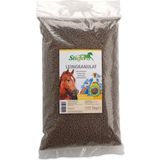 5.0 (7)
5.0 (7)Stiefel Linseed Granules, 5 kg
- Ready-to-feed linseed cake
- High mucilage content
- Reduced fat content due to cold pressing
£17.80 (£3.56 / kg)Delivery by January 05
-
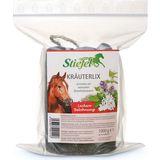 4.8 (10)
4.8 (10)Stiefel Kräuterlix Horse Lick, 1 kg
- Lick stone with bronchial herbs
- A tasty reward
- With attached cord to tie it up
£13.33 (£13.33 / kg)Delivery by January 05
-
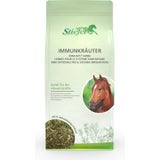 5.0 (7)
5.0 (7)Stiefel Immunity Herbs , 1 kg
New!- 100% natural herbal mixture
- Immunity herbs
- Good for the body's defences
£22.27 (£22.27 / kg)Delivery by January 05
-
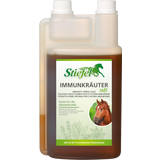 4.8 (6)
4.8 (6)Stiefel Immunity Herbal Liquid, 1 l
New!- To support the immune system
- Made of 100% natural herbs
- No added sugar
£15.12 (£15.12 / l)Delivery by January 05
-
Great Britain: Free standard delivery from £79.90
-
Free
returns Secure payments
with SSL encryption technology

